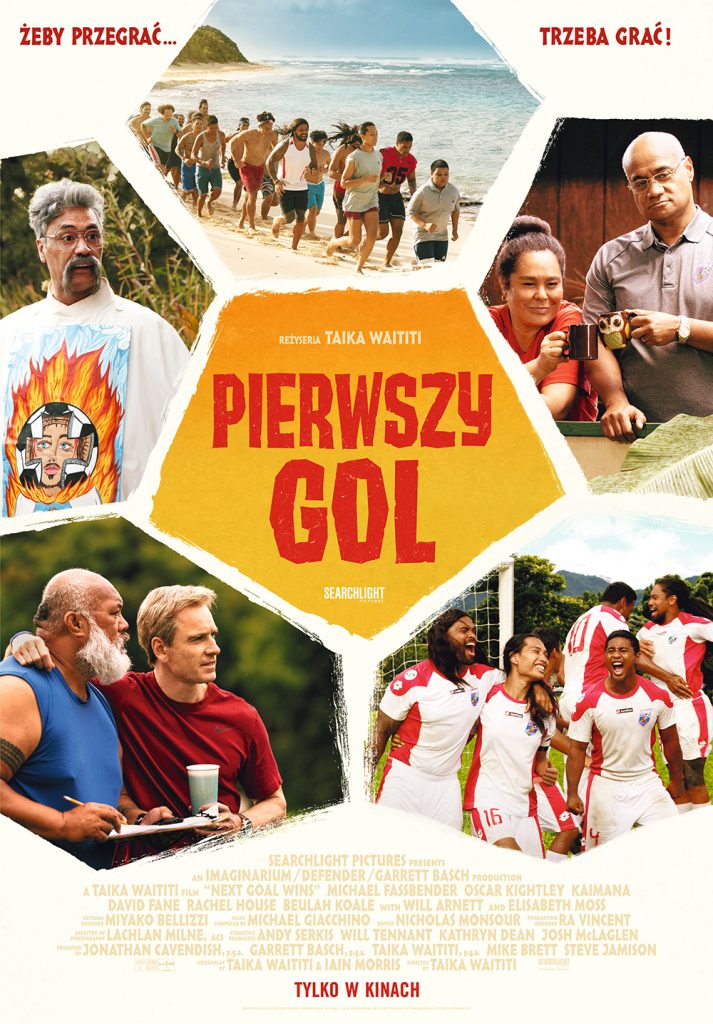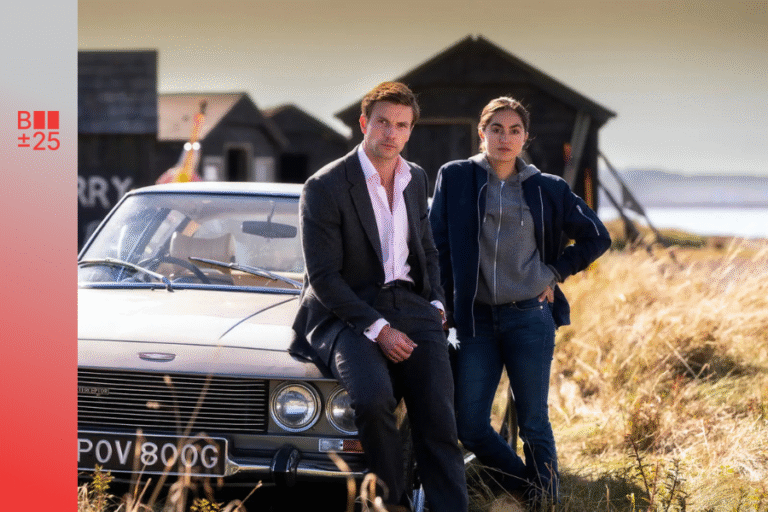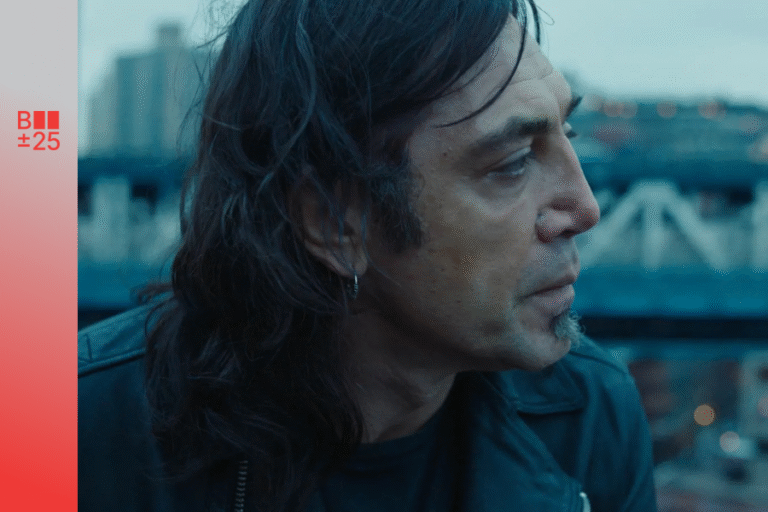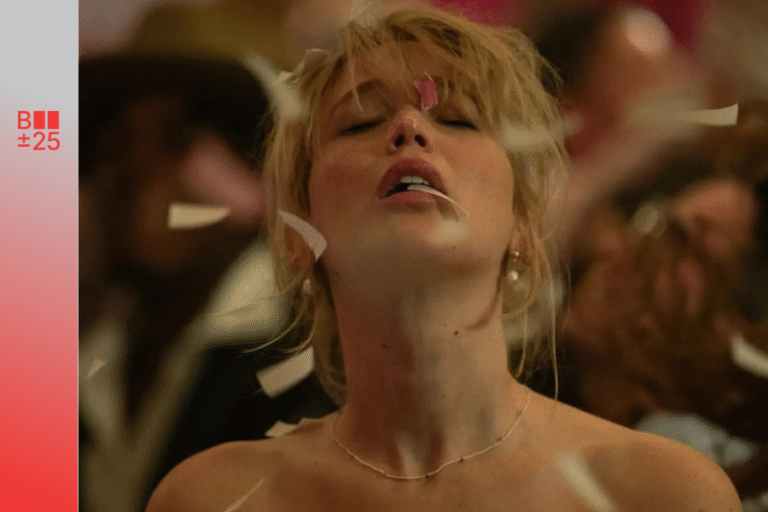
„Pierwszy gol”, komedia w reżyserii nagrodzonego Oscarem® Taiki Waititiego („Jojo Rabbit”, „Thor: Ragnarok”), opowiada historię reprezentacji Samoa Amerykańskiego w piłce nożnej. Najgorsza drużyna świata, która zasłynęła spektakularną klęską, przygrywając 31:0 w eliminacjach do Mistrzostw Świata w 2001 roku, zatrudnia trenera ostatniej szansy, Thomasa Rongena (Michael Fassbender), mając nadzieję, że ten odwróci jej los.
PL
Efekt wyjątkowej współpracy British Film Festival i BBC Studios: specjalny, przedpremierowy pokaz dwóch pierwszych odcinków serialu kryminalnego opartego na bestsellerowych powieściach Elizabeth George.
Zanim produkcja trafi na platformy VOD, widzowie festiwalu jako pierwsi w Polsce będą mieli okazję zobaczyć jej początek na dużym ekranie. Decyzja o kinowej prezentacji nie jest przypadkowa – najlepsze produkcje BBC Studios od dawna charakteryzuje jakość, wizualna i narracyjna, która w pełni wybrzmiewa właśnie w warunkach kinowych.
Centralnym punktem serialu jest dynamiczna relacja dwojga detektywów ze Scotland Yardu, którzy pochodzą z zupełnie różnych środowisk. Inspektor Thomas Lynley to arystokrata i absolwent Oksfordu, poruszający się swobodnie w świecie brytyjskich wyższych sfer. Nową partnerką Lynleya zostaje sierżant Barbara Havers – jego całkowity kontrast. To pragmatyczna, wywodząca się z klasy robotniczej policjantka, która wszystko, co osiągnęła, zawdzięcza własnej pracy i uporowi.
Ten pozornie niedobrany duet musi nauczyć się współpracy, by rozwiązywać skomplikowane sprawy morderstw, które prowadzą ich przez malownicze, lecz pełne mrocznych sekretów zakątki Wysp. To właśnie napięcie – między eleganckim światem Lynleya a szorstką rzeczywistością policyjnej pracy Havers – tworzy fundament serialu i sprawia, że jest on czymś więcej niż standardową opowieścią kryminalną. To inteligentna rozrywka i starannie zarysowany portret społecznych podziałów, z którymi Wielka Brytania mierzy się od lat.
ENG
Here’s the result of an exceptional collaboration between the British Film Festival and BBC Studios: a special pre-premiere screening of the first two episodes of a brand-new crime series based on the bestselling novels by Elizabeth George.
Before its official release on streaming platforms, festival audiences will be the first in Poland to experience its gripping opening on the big screen. The decision to present it in cinemas is no coincidence – BBC Studios’ finest productions have long been distinguished by a visual and narrative quality that truly comes alive in a theatrical setting.
At the heart of the series lies the dynamic relationship between two Scotland Yard detectives from utterly different worlds. Inspector Thomas Lynley is an aristocrat and Oxford graduate, perfectly at ease among Britain’s upper classes. His new partner, Sergeant Barbara Havers, is his complete opposite: she is a working-class officer who has earned every success through sheer grit and determination.
This seemingly mismatched duo must learn to work together to solve complex murder cases that lead them through Britain’s most picturesque yet secret-filled corners. The tension between Lynley’s refined world and Havers’s rough-and-ready policing is what gives the series its edge, elevating it far beyond the conventions of the genre. Intelligent, stylish, and socially aware, LYNLEY offers both gripping entertainment and a sharp portrait of the class divides that continue to shape modern Britain.
PL
Andrea Dunbar swój pierwszy dramat napisała jako nastolatka. Miała 15 lat, mieszkała w Bradford, w jednej z najtrudniejszych dzielnic miasta, Buttershaw. To właśnie w niej rozgrywa się sztuka Dunbar THE ARBOR, na poły autobiograficzna opowieść o dziewczynie, która zachodzi w ciążę ze swoim dość zresztą przypadkowym chłopakiem. Dwa kolejne teksty dramaturżki przyniosły nieoczekiwany sukces – na podstawie tekstu RITA, SUE AND BOB TOO Alan Clarke zrobił w 1986 roku film, jej dramaty były wystawiane w prestiżowym londyńskim Royal Court Theatre. Andrea nigdy jednak nie opuściła Buttershaw, a jej życie potoczyło się raczej w zgodzie z brutalną logiką jej tekstów, nie teatralnego sukcesu. Zmarła w wieku 29 lat, pozostawiając trójkę dzieci, które wychowywała samotnie.
20 lat po jej śmierci Clio Barnard, artystka wizualna, a dziś jedna z najważniejszych współczesnych reżyserek brytyjskich, powróciła do historii Andrei i zrealizowała własne THE ARBOR – niezwykły projekt fikcjonalno-dokumentalny, który jest jednocześnie adaptacją jej pierwszej sztuki, biografią samej Dunbar, a także jej najstarszej córki, która w pewnym sensie powtórzyła losy matki. Barnard zastosowała niezwykły zabieg: słyszymy wywiady nagrane z rodziną i znajomymi Andrei, ale oglądamy aktorów, którzy synchronizują swoją grę z podłożonym tekstem. W efekcie powstaje wielopiętrowa konstrukcja łącząca fikcję z rzeczywistością, sztukę z życiem, nieżyjącą matkę z jej córkami. Samo miejsce, ulica THE ARBOR, staje się zaś nie tylko tłem, ale też jednym z głównych bohaterów tego wstrząsającego filmu.
ENG
Andrea Dunbar wrote her first play as a teenager. At fifteen, she was living in Buttershaw, one of the most deprived districts of Bradford, the very setting of her debut work, THE ARBOR, a semi-autobiographical tale of a girl who falls pregnant by her rather casual boyfriend. Dunbar’s next two plays brought unexpected acclaim: Alan Clarke adapted her RITA, SUE AND BOB TOO into a 1986 feature, while her plays were staged at London’s prestigious Royal Court Theatre. Yet Andrea herself never left Buttershaw, and her life followed the harsh logic of her writing rather than the promise of theatrical success. She died at the age of twenty-nine, leaving behind three children whom she had raised alone.
Two decades after her death, visual artist - and now one of Britain’s most vital contemporary filmmakers - Clio Barnard returned to Andrea’s story to create her own THE ARBOR: a remarkable hybrid of fiction and documentary that is at once an adaptation of the first play, a portrait of Dunbar herself, and of her eldest daughter, who in some ways relived her mother’s fate. Barnard employed a striking device: we hear the voices of Andrea’s family and friends from recorded interviews, but we see actors lip-synching those words on screen. The result is a layered construction, interweaving fiction with reality, art with life, the absent mother with her daughters. The street itself, THE ARBOR, emerges not merely as a backdrop but as one of the film’s central characters.
PL
Od pierwszych ujęć w krótkich filmach Sally Potter widać, że gest i ruch odgrywają niezwykle ważną rolę w budowaniu znaczenia, a szacunek dla wolności artystycznej stanowi fundament jej twórczości. Już w JERK - filmie, który stworzyła mając zaledwie 20 lat - Sally Potter testuje granice filmu, łącząc twarze w dynamiczny montaż i obserwując gesty mężczyzny, którego widzimy na ekranie, a nawet zwykłe otwierające się okno staje się nośnikiem znaczeń dzięki eksperymentalnemu podejściu do rejestracji obrazu. Ta wrażliwość wobec ruchu, przestrzeni i rytmu osiąga pełnię w HORS D’OUVRES, w którym łączy materiały na taśmie 8 mm i 16 mm, wyświetlając je na szkle i rejestrując ponownie. Te zmieniają percepcję widza - światło prowadzi wzrok, a każdy ruch tancerzy zyskuje nową głębię przy kolejnym spojrzeniu.
W filmach Sally Potter czuć zaufanie do widza - wierzy, że potrafi dostrzec odniesienia, wyłapać znaczenia, a jednocześnie pozwala odbiorcy poczuć i interpretować obraz po swojemu. To podejście staje się szczególnie wyraźne w PLAY, w ktorym obserwujemy grupę bawiących się dzieci. Jednak dzięki zastosowaniu split screenu, charakterystycznej ścieżki dźwiękowej, doboru kolorów, film podważa niewinność tej sceny. Zaczynamy doszukiwać się głębszych warstw i kontekstów. PLAY bawi się naszą percepcją, i zdaje się być studium samego aktu bycia obserwowanym, i tego, jak warstwy filmowego języka mogą prowadzić tę obserwację w wielu, zaskakujących kierunkach. Podobną świadomość i precyzję pracy z przestrzenią, kolorem i montażem Potter prezentuje w jej ostatnim filmie LOOK AT ME. Napięcie między Javierem Bardemem a Chrisem Rockiem tworzy dynamiczną grę sił i charakterów, ambicji i ego, artystycznej wolności i partnerskiego wsparcia, osadzoną w przestrzeni precyzyjnie ukształtowanej pod kątem emocjonalnych i psychologicznych relacji między bohaterami.
Ta otwartość na eksperyment łączy się u Sally Potter z wyraźną świadomością kontekstu społecznego i politycznego, co widać zarówno w krótkich, jak i w pełnometrażowych filmach. W filmie THRILLER reinterpretacja historii Mimi z Cyganerii Pucciniego nadaje bohaterce sprawczość i podmiotowość, kwestionując mizoginiczny obraz kobiety, której los w opowieści prowadzi nieuchronnie do śmierci. Film pokazuje znacznie więcej: jej wątpliwości, jej emocje, i nareszcie - jej perspektywę własnego życia. W THE LONDON STORY, szpiegowski thriller przekształca się w grę absurdów i groteskowych sytuacji, gdzie scena tanga przy muzyce Romeo and Juliet Prokofiewa staje się zarówno wizualnym symbolem absurdu, jak i subtelnym komentarzem do polityki Wielkiej Brytanii lat 80.
Krótki metraż ma ten ogromny przywilej: pozwala na eksplorowanie kina wolnego od budżetowej presji, producenckich wymagań i box office’owych przechwałek. W twórczości tak nieustępliwej i kierującej się niezwykłą ciekawością formalną artystki jak Sally Potter, ten format odsłania się w szczególnie interesujący sposób, pokazując, jak odważnie można przekraczać przyjęte konwencje i rozwijać artystyczną oraz narracyjną wizję.
ENG
From the very first shots in Sally Potter's short films, it is clear that gesture and movement play an extremely prominent role in constructing meaning, and the respect for artistic freedom is the foundation of her work. Already in JERK, a film she made when she was only 20, she is pushing at the edges of cinema, splicing faces into dynamic editing, dwelling on the gestures of a man on screen, and even imbuing the simple opening of a window with layers of significance through an experimental play with image-making. This sensitivity to movement, space and rhythm reaches its peak in HORS D'OUVRES, where she combines 8 mm and 16 mm footage, projecting it onto glass and re-recording it. These change the viewer's perception: the light guides the eye, and each movement of the dancers gains new depth with each subsequent glance.
Sally Potter’s work is built on trust in her audience – the belief that they can catch references, tease out meanings, yet also feel and interpret freely in their own way. That becomes especially striking in PLAY, which on the surface follows a group of children at play. Yet through split-screen, a distinctive soundtrack and carefully chosen colours, Potter undermines the supposed innocence of the scene. The film nudges us to look for hidden layers and subtexts. PLAY toys with perception itself, becoming a study of what it means to be observed, and how the layers of cinematic language can steer that observation in multiple, often surprising directions. That same precision and awareness of space, colour and montage is at work in her most recent short, LOOK AT ME. The charged dynamic between Javier Bardem and Chris Rock unfolds as a power play of ego and ambition, freedom and collaboration, staged in a space meticulously calibrated to the emotional and psychological relations between its characters.
Potter’s openness to experiment is inseparable from her sharp sense of social and political context, evident across both her shorts and features. In THRILLER, Puccini’s Mimi from La Bohème is reimagined with agency and subjectivity, dismantling the misogynistic framing of a woman fated only for death. Potter grants her doubts, her emotions, and at last, her own perspective on life. Meanwhile, THE LONDON STORY twists the spy thriller into a farce of absurd and grotesque encounters, where a tango sequence set to Prokofiev’s Romeo and Juliet works both as a deliriously visual joke and a sly commentary on 1980s British politics.
Short films have this enormous privilege: they allow cinema to be explored free from the pressures of budgets, producers and box-office demands. In the hands of an artist as relentless and driven by extraordinary formal curiosity as Sally Potter, this format compellingly reveals itself, showing how boldly one can transcend accepted conventions and develop an artistic and narrative vision.
PL
Lynne Ramsay, gościni i bohaterka retrospektywy reżyserskiej podczas British Film Festival 2024, powraca z dziełem totalnym. ZGIŃ, KOCHANIE to kolejny dowód niezwykle czujnego spojrzenia i przenikliwej wrażliwości, która jak nikt inny potrafi przełożyć mroczne stany duszy na unikalny język wizualny.
Ramsay zabiera nas do odległej Montany, gdzie Grace i Jackson (Jennifer Lawrence i Robert Pattinson) postanawiają zrealizować marzenie o ucieczce od miejskiego zgiełku. Ich sielanka w drewnianym domu pośrodku głuszy szybko jednak odsłania swoje drugie, mroczne oblicze. Ramsay z chirurgiczną precyzją pokazuje, jak idylliczna fasada pęka pod ciężarem izolacji i nowych obowiązków po narodzinach dziecka. To właśnie wtedy rozpoczyna się hipnotyzujące studium psychologicznego rozkładu.
Ekranem rządzi Jennifer Lawrence w roli Grace, która tworzy kreację wybitną, być może najważniejszą w jej dotychczasowej karierze. Jej portret kobiety pogrążającej się w otchłani depresji poporodowej, uwięzionej między utraconą tożsamością a (nie)chcianą rolą matki, magnetyzuje i porywa. Ramsay prowadzi swoją aktorkę przez najciemniejsze zakamarki emocji, budując opowieść, która jest jednocześnie brutalnie szczera i poetycko piękna.
ZGIŃ, KOCHANIE porusza, olśniewa wizualnie i umacnia pozycję Ramsay jako jednej z najbardziej bezkompromisowych autorek współczesnego kina.
ENG
Lynne Ramsay, guest of honour and focus of the directorial retrospective at the 2024 British Film Festival, returns with a work of pure cinematic mastery. DIE, MY LOVE is yet another testament to her extraordinary eye and rare sensitivity, a filmmaker uniquely capable of translating the darkest corners of the human soul into a distinctive visual language.
Ramsay takes us deep into the wilds of Montana, where Grace and Jackson (Jennifer Lawrence and Robert Pattinson) set out to live their dream of escaping the noise and chaos of city life. Yet the supposed idyll of their wooden cabin in the middle of nowhere soon reveals its darker side. With surgical precision, Ramsay exposes how the fragile façade of bliss begins to crack under the strain of isolation and the relentless demands of new parenthood. What follows is a hypnotic study in psychological unravelling.
The screen belongs entirely to Jennifer Lawrence as Grace, in what may well be the most powerful performance of her career to date. Her portrayal of a woman sinking into the abyss of postnatal depression - trapped between a lost sense of self and the (un)wanted role of motherhood - is magnetic and utterly gripping. Ramsay guides her star through the murkiest depths of emotion, crafting a story that is at once brutally honest and hauntingly beautiful. DIE, MY LOVE is a film that stirs, dazzles and confirms Ramsay’s place as one of the most fearless and uncompromising voices in contemporary cinema.



